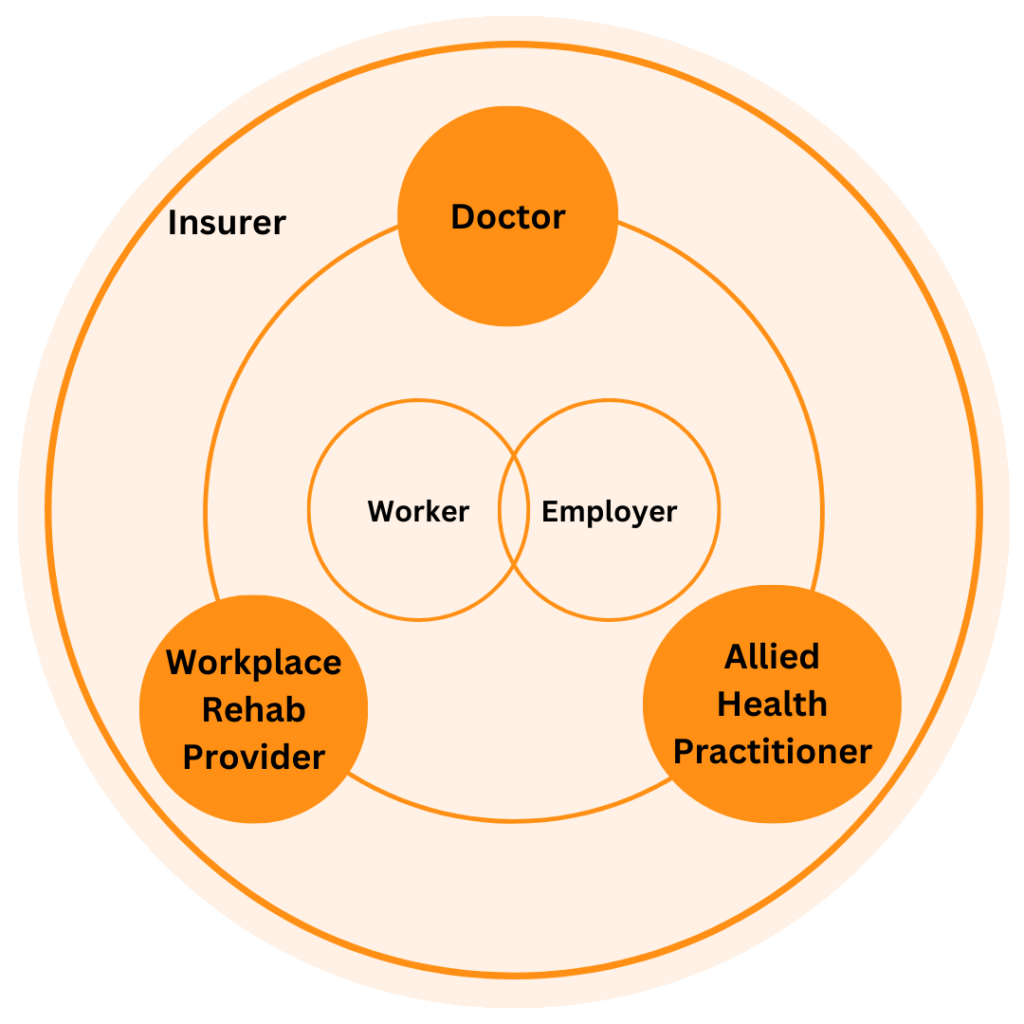Partnering Healthcare Professionals for Effective WorkCover Solutions
)
Are there ways to minimise potential losses? Absolutely. For employers, being proactively involved in WorkCover cases not only reduces the financial impact on your business, it also fosters a supportive environment that strengthens your relationship with your employees.
Keep reading to find out how you can be an engaged employer within the workers comp system, to help pave the way for a smooth return to work journey.
Note: In this article, we use “WorkCover” and “workers comp” interchangeably to refer to your workers compensation case, but the term WorkCover is no longer in use. See Safework NSW for more details.
Who’s Involved in a Workers Comp CaseWithin any WorkCover case, the support team refers to the parties involved in ensuring a safe and sustainable recovery process for the injured worker. These key stakeholders include:
- Injured Worker: Central figure of the work rehab process.
Insurance Case Manager aka Insurer: Primary contact for the support team, oversees the compensation claim and coordinates with other stakeholders. - Nominated Treating Doctor (NTD): Provides ongoing care, performs medical assessments, and develops treatment plans.
Allied Health Providers: Specialists who address the specific health needs of the injured worker. - Workplace Rehabilitation Provider (that’s us): Health professionals who address the physical, functional, psychological, and workplace barriers that may hinder a worker’s recovery or return to work.
- Employer: Often assisted by a Return to Work Coordinator, an employer’s role is crucial in supporting the recovery process.

Did you know you hold a vital position in the workers compensation case? Here, we outline your key legal responsibilities in the process of a worker’s recovery journey.
- Developing a Return to Work (RTW) Program: You must establish a RTW program within 12 months of becoming an employer. This program outlines your procedures for managing work-related injuries or illnesses and should align with your insurer’s injury management plan.
- Prompt Injury Notification: Report workplace injuries to your workers compensation insurer within 48 hours of occurrence.
- Participation in Injury Management: Engage actively in developing and executing the worker’s injury management plan, which is prepared by your insurer.
- Maintaining an Injury Register: Record details of the injury, including the injured worker’s name, injury description, and circumstances in a register.
- Providing Suitable Duties: Identify and offer work duties that match the worker’s capacity. Consider developing a recover at work plan (more in the next section).
- Job Security: Do not terminate the employment of an injured worker within six months of their injury.
Shared goals, communication and cooperation among a support team are critical in achieving positive clinical and occupational outcomes in the WorkCover case. Staying engaged in the recovery process helps workers return to their regular duties sooner, whilst also building trust and rapport with employees.
Here are some strategies for effective collaboration:
- Early Contact with WorkCover Doctor: Initiate early communication with the worker’s doctor to demonstrate your commitment to their recovery and discuss suitable duties.
- Ensure Smooth Communication: Maintain regular contact with the injured worker, the workplace rehabilitation consultant, and the insurer to keep everyone informed and aligned.
- Developing a Recover at Work Plan: Use the Certificate of Capacity provided by the WorkCover doctor to understand the worker’s abilities, then identify suitable duties and create a detailed recover at work plan with the assistance of the rehab consultant.
- Collaborate with Workplace Rehab Providers: Studies by SIRA show that early involvement of a workplace rehabilitation provider reduces both weekly and medical costs. Continuous engagement with rehab providers like AusRehab is crucial for optimising the rehab process.
- Offer Education and Training: Educating your employees through seminars and workshops is key to injury prevention. Past clients have benefited from our safe manual handling seminar offering, so enquire with us today to see if you’re eligible for the service.
Here at AusRehab, we’re dedicated to supporting injured workers and ensuring their safe return to work since our founding in 2019. We take the time to understand each unique WorkCover case and provide customised solutions. Our expertise in workers compensation and CTP claims, along with our commitment to delivering the best results, has helped us achieve an impressive return-to-work rate of nearly 90%.
If you’re ready to take the first step to elevate your organisation, speak to us to find out how we can deliver you to your expectations and beyond.
 Ginny Cai - Ginny Cai is a dedicated writer with extensive experience in digital marketing and content creation. She is passionate about transforming data insights into compelling narratives and strategic content across multiple platforms.
Ginny Cai - Ginny Cai is a dedicated writer with extensive experience in digital marketing and content creation. She is passionate about transforming data insights into compelling narratives and strategic content across multiple platforms.

